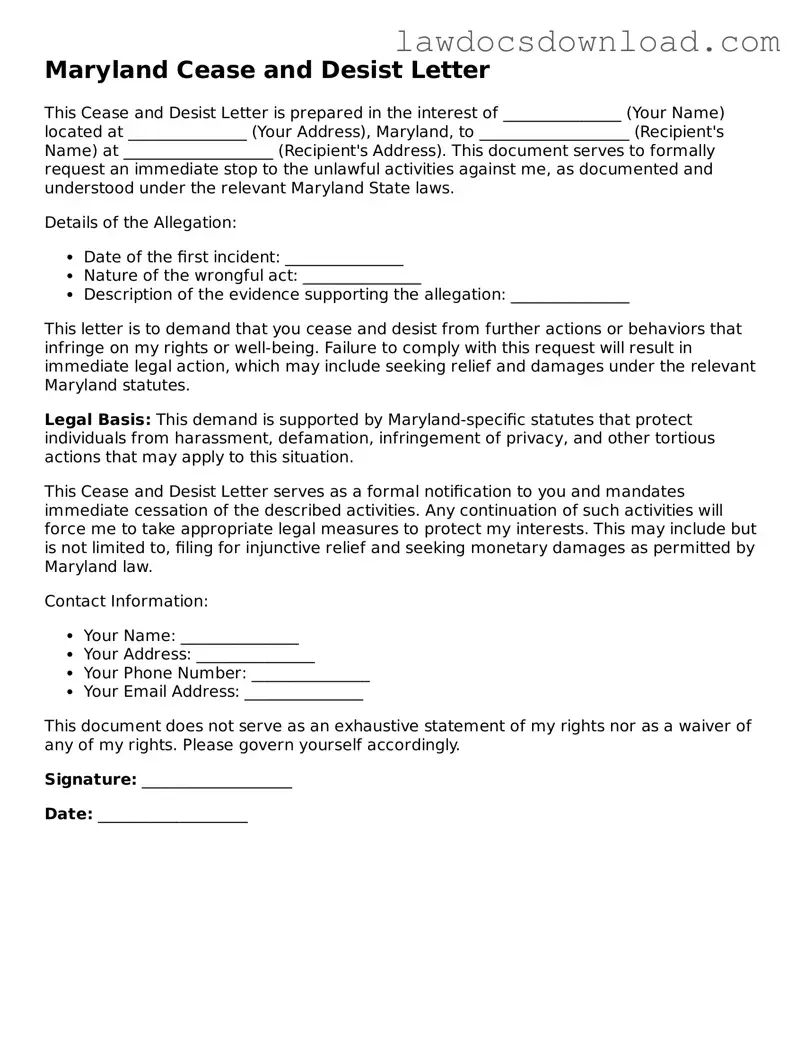The Maryland Cease and Desist Letter form is similar to a Restraining Order Request in that both seek to legally prevent someone from engaging in certain behaviors. However, while the cease and desist letter is a formal request that can be initiated by an individual or an attorney and does not require a judge's approval, a restraining order is a legal order issued by a court that mandates someone to do or not to do something, backed by legal consequences for non-compliance.
It also shares similarities with a Trademark Infringement Letter, as both documents are used to formally request an individual or entity to stop unauthorized activities. Trademark Infringement Letters are specifically focused on violations related to trademark law, like unauthorized use of a trademarked logo or name, whereas cease and desist letters can cover a broader range of issues including but not limited to trademark infringement.
Comparable to a Non-Disclosure Agreement (NDA) Violation Letter, the cease and desist letter can be used when someone breaches a confidentiality agreement. Both letters serve the purpose of alerting the violator of their breach and demanding they stop their prohibited actions. However, an NDA Violation Letter is specifically centered on the breach of a previously agreed-upon NDA, while a cease and desist letter can address a variety of issues beyond confidentiality breaches.
A Notice of Breach of Contract is similar to the Maryland Cease and Desist Letter in that it addresses the violation of an agreement's terms by one party and demands correction of the breach. While the Notice of Breach of Contract strictly pertains to breaches of contractual obligations, a cease and desist letter can be applied to infractions outside of formal agreements, including harassment or defamation.
Similar to a Copyright Infringement Letter, the Maryland Cease and Desist Letter can be used to stop unauthorized use of copyrighted material. However, the Copyright Infringement Letter specifically targets violations of copyright law, like unauthorized reproduction or distribution of copyrighted content, whereas a cease and desist letter has a wider application and can also address other forms of infringement or misconduct.
The Comment of Defamation Letter bears resemblance to the cease and desist letter regarding its intent to protect an individual's or entity's reputation. Both letters demand the cessation of defamatory statements. However, the Comment of Defamation Letter focuses exclusively on defamation, either libel or slander, while the cease and desist letter can encompass a variety of legal issues, including but not limited to defamation.
Similar in intent to a Letter of Intent (LOI) regarding dispute resolution, the Maryland Cease and Desist Letter form aims to resolve conflicts without resorting to litigation. Both documents represent an initial step to address grievances. However, while an LOI might propose negotiations or outline the terms of a possible agreement, a cease and desist letter specifically demands the cessation of the offending behavior.
An Eviction Notice is akin to the cease and desist letter in terms of its aim to alter the behavior of the recipient. Specifically, it requires the tenant to correct a lease violation or vacate the premises. Though an Eviction Notice is limited to landlord-tenant relationships and property law, both documents serve the purpose of notifying the recipient of problematic behavior and requesting changes.
Lastly, a Privacy Complaint Letter and the Maryland Cease and Desist Letter have common ground when it comes to addressing violations of one's privacy. Both letters can demand the cessation of actions that invade personal privacy or misuse personal information. Yet, a Privacy Complaint Letter specifically addresses breaches of privacy laws or policies, while a cease and desist letter is versatile, with possible applications in various situations including privacy concerns.
